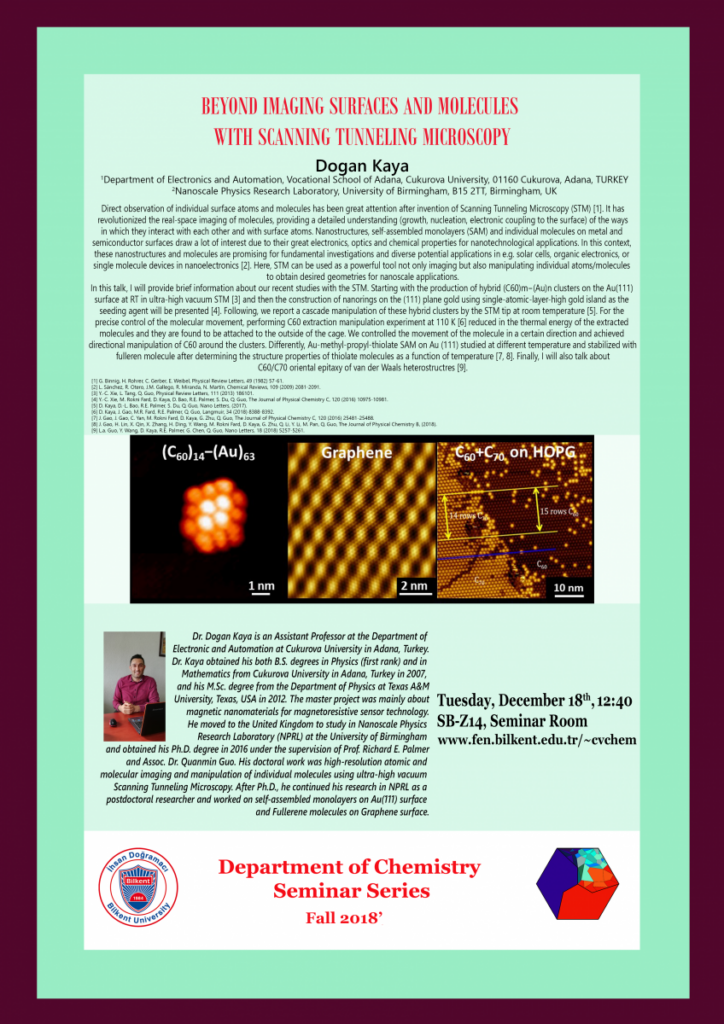Fall '18 Department Seminars with Dr. Doğan Kaya
Title: Beyond Imaging Surfaces and Molecules with Scanning Tunelling Microscopy
Speaker: Dr. Doğan Kaya
Department of Electronics and Automation, Çukurova University
Adana, Türkiye
Date: December 18, 2018, Tuesday
Time: 12:40
Place: Departmental Seminar Room (SB-Z14)

Abstract:
Direct observation of individual surface atoms and molecules has been great attention after invention of Scanning Tunneling Microscopy (STM) [1]. It has revolutionized the real-space imaging of molecules, providing a detailed understanding (growth, nucleation, electronic coupling to the surface) of the ways in which they interact with each other and with surface atoms. Nanostructures, self-assembled monolayers (SAM) and individual molecules on metal and semiconductor surfaces draw a lot of interest due to their great electronics, optics and chemical properties for nanotechnological applications. In this context, these nanostructures and molecules are promising for fundamental investigations and diverse potential applications in e.g. solar cells, organic electronics, or single molecule devices in nanoelectronics [2]. Here, STM can be used as a powerful tool not only imaging but also manipulating individual atoms/molecules to obtain desired geometries for nanoscale applications.
In this talk, I will provide brief information about our recent studies with the STM. Starting with the production of hybrid (C60)m-(Au)n clusters on the Au(111) surface at RT in ultra-high vacuum STM [3] and then the construction of nanorings on the (111) plane gold using single-atomic-layer-high gold island as the seeding agent will be presented [4]. Following, we report a cascade manipulation of these hybrid clusters by the STM tip at room temperature [5]. For the precise control of the molecular movement, performing C60 extraction manipulation experiment at 110 K [6] reduced in the thermal energy of the extracted molecules and they are found to be attached to the outside of the cage. We controlled the movement of the molecule in a certain direction and achieved directional manipulation of C60 around the clusters. Differently, Au-methyl-propyl-thiolate SAM on Au (111) studied at different temperature and stabilized with fulleren molecule after determining the structure properties of thiolate molecules as a function of temperature [7, 8]. Finally, I will also talk about C60/C70 oriental epitaxy of van der Waals heterostructres [9].
[1] G. Binnig, H. Rohrer C. Gerber, E. Weibel Physical Review Letters, 49 (1982) 57-61.
[2] L. Sánchez, R. Otero, LM. Gallego, R. Miranda, N. Martin, Chemical Reviews, 109 (2009) 2081-2091.
[3] Y.-C. Xie, L. Tang, Q. Guo, Physical Review Letters, 111 (2013) 186101.
[4] Y.-C. Xie, M. Rokni Fard. D. Kaya, D. Bao, R.E. Palmer S. Du Q Gua. The Journal of Physical Chemistry C. 120 (2016) 10975-10981.
[5] D. Kaya, D.-L. Bao, R.E. Palmer S. Du Q Guo, Nano Letters (2017)
16) D. Kaya, Gao, MR. Fard, RE. Palmer Q Guo, Langmuir, 34 (2018) 8388-8392.
[7] Gao, Gao, C. Yan, M. Rokni Fard, D. Kaya, G. Zhu, Q Guo, The Journal of Physical Chemistry C, 120 (2016) 25481-25488
[8] Gao, H. Lin, X. Qin, X. Zhang, H. Ding, Y. Wang, M. Rokni Fard. D. Kaya, G. Zhu QUYUM Pan, Q Guo, The Journal of Physical Chemistry B. (2018)
[9] La Guo, Y. Wang, D. Kaya, R.E. Palmer G. Chen Q Guo, Nano Letters, 18 (2018) 5257-5261
Short Biography of the Speaker:
Dr. Dogan Kaya is an Assistant Professor at the Department of Electronic and Automation at Cukurova University in Adana, Turkey. Dr. Kaya obtained his both B.S. degrees in Physics (first rank) and in Mathematics from Cukurova University in Adana, Turkey in 2007, and his M.Sc. degree from the Department of Physics at Texas A&M University, Texas, USA in 2012. The master project was mainly about magnetic nanomaterials for magnetoresistive sensor technology.
He moved to the United Kingdom to study in Nanoscale Physics Research Laboratory (NPRL) at the University of Birmingham and obtained his Ph.D. degree in 2016 under the supervision of Prof. Richard E. Palmer and Assoc. Dr. Quanmin Guo. His doctoral work was high-resolution atomic and molecular imaging and manipulation of individual molecules using ultra-high vacuum Scanning Tunneling Microscopy. After Ph.D., he continued his research in NPRL as a postdoctoral researcher and worked on self-assembled monolayers on Au(111) surfaces.